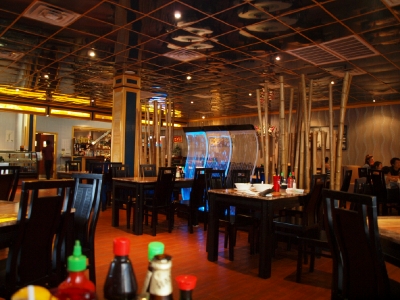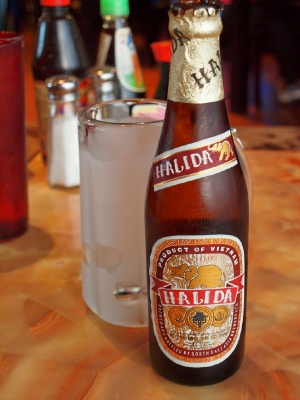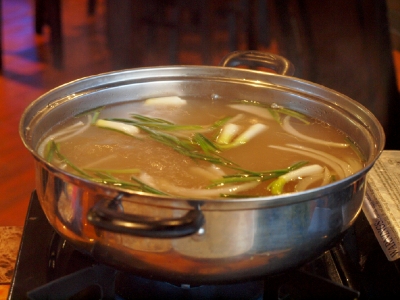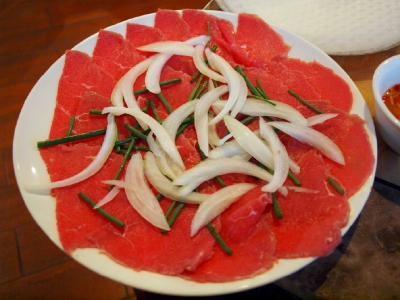
Tuesday, June 8. Beef Sandwich From Bear's. Beef Fondue At Pho Orchid. Some Thoughts On Vietnamese Food. The Marys made a sortie into Mandeville for reasons I'm better off not knowing about. One of the targets was Bear's, where Mary Ann would score a poor boy and Mary Leigh would down a large order of cheese fries--the only thing she eats there, but enough of a lure to have Bear's on her A-list.
My loving wife brought home a small roast beef poor boy for me. The French bread was thoroughly saturated with gravy, beginning to dissolve in it. (Another reason never to get take-out anything.)
But I know how to fix this problem. I cut the sandwich in half (no way I can finish a whole one), put one half on a wire rack atop a pizza pan, and put it into the oven at 400 degrees. Eight minutes later (the oven wasn't pre-heated), I took out a crisp, hot poor boy, and relished eating it. Not quite as good as if it had come right out of the restaurant's oven (the lettuce had wilted, among other fine details injured). But a nice treat for lunch.
Tuesday is my Ethnic Day. I don't know how or why that got started, but it goes back to my earliest radio restaurant reviews, in 1975. I did one every day, and it helped to have some sort of framework. Ethnic Day influences my choice for Tuesday dinner venues, too.
Tonight I was at Pho Orchid in Metairie. It has never been busy when I've gone, but any call from a listener always radiates praise. It's a Vietnamese restaurant specializing in the beef noodle soup of its first name, but its menu is more comprehensive than most Viet cafes.

Pho Orchid is also a nicer-looking restaurant than most in that category. The address has seen enough former restaurants to require both hands to count. The current owners thoroughly renovated the space, making it dark, cool, and elegant. They're not quite finished, apparently. One wall was covered with plastic sheeting while new windows are installed.

I've had the pho and the bun and the spring rolls and the other Vietnamese standards here. Tonight I wanted to push on into something more elaborate. While looking over the menu from the other wide of a bottle of a Halida Vietnamese beer, I saw that they offer a number of variations on beef fondue. This is a less-than-accurate name--but there's no other English word for it.

Vietnamese fondue is prepared atop the table, and you do it yourself. A pan of stock with savory vegetables simmers over a little propane burner. The variation I ordered had a good bit of vinegar in it, too. Then come the bowls of the same sorts of things you get with pho: fresh basil, lettuce, cilantro, cooked noodles, a couple of spicy dipping sauces.
On another plate was a stack of rice paper "pancakes" (another imperfect translation). These look and feel as if they're made of stiff, translucent plastic, and not particularly edible. But dip them into the big bowl of hot water, and they become wet, slippery ghosts, gossamer thin but surprisingly strong and stretchy. The transformation reminded me of what happens when you stuff a wad of cotton candy in your mouth and, a second later, wonder where it went.

The final plate to arrive on this now very crowded table bore slices of raw beef, thin enough to let light pass. I'm not positive, but it looked like round steak.
How all this stuff merges into a dish is complex enough to require outline form:
1. Soften one of the rice papers, by rotating it in the bowl of hot water until it's entirely wet.
2. Position the rice paper on the plate. This takes a little dexterity, because the thing is not only like thin silk but it sticks to itself and anything else it touches.
3. Tear off a few green leaves and drop them in the center of the rice paper.
4. Chopstick up a small bundle of the cool rice noodles and try to extend them along one diameter of the rice paper, leaving an open space at one limb of the pancake.
5. Pick up a slice or two of the beef and swish it in the simmering stock until it's cooked to satisfaction. (Even well-done, this only takes a few seconds.) In this it's identical to the Japanese dish shabu-shabu (so named for the sound one makes when swishing the beef).
6. Let the beef drain for a second, then move it atop the pile of stuff on the rice paper.
7. Roll the rice paper up. Fold over the unfilled end. Dip this roll in one of the sauces. Raise it to the lips. Open mouth. Insert roll. Eat.
The lady who (I think) owns the place came over to tell me I was doing something wrong. At first, I spooned the sauce onto the pile before rolling. She said that the contents of any rice paper-wrapped roll must be kept as dry as possible, or the rice paper will become unmanageably slippery. Which it indeed was in my first attempt. Live and learn.
At the end of the procedure, there is an eighth step. The vegetable-filled stock in which all the beef has been swished is now a soup. And enough noodles and vegetables remain to make it into something very much like pho.
Noting that, I decided to commit to virtual paper something that's been on my mind for years now. In that time I've waited for the magic of Vietnamese cookery to convince me of its brilliance. The way it has to so many other New Orleans diners. There had to be more to the cuisine than I was tasting. And I have been eating Vietnamese longer than most of its most avid, non-Asian local fans have been alive.
Okay. I like Vietnamese cooking well enough. This dinner was very interesting. (It must have been for me to get three pages out of one dish.) But the appeal came more from its exotic provenance, not its flavor. Even with all the folderol, what this boiled down to (literally) was a different way of serving pho. Broth, beef, noodles, herbs. Almost everything in most Vietnamese restaurants is a variation on pho. Which is not so interesting a flavor that it requires a hundred or more listings on a menu.
Take out all the forms of pho, the spring rolls, and the undeniably delicious mystery-meat banh mi sandwiches (Vietnamese poor boys), and most Vietnamese restaurants are left with little on the menu. A few--Kim Son, Nine Roses, Café Minh, and now Pho Orchid--get a bunch of my stars by having much bigger and more widely varied menus. But those aren't the ones people rave about. The simplest pho shops get all the attention.
I read an article in the New York Times a few weeks ago about the resurgence of the New Orleans restaurant scene. I was astonished by the writer's ten best places to dine in New Orleans. In it were three Vietnamese restaurants, all of them pho and banh-mi shops. What? Did he talk with anybody here over the age of thirty, living outside the Marigny and Bywater? To read the article, you'd think pho were more important to the local eating scheme than gumbo is.
Vietnamese food is unquestionably unique, fresh, and interesting. The people command the highest respect for their victories against unimaginable adversities, for their matchless work ethic, and for their determination to preserve their culture.
But if I never ate another bowl of pho, I wouldn't miss it.
I'm hoping this rumination kicks off a big controversy on the messageboard, so I can find what it is I should be missing. If anything.
![]()
![]()
![]() Pho Orchid. Metairie: 3117 Houma Blvd.. 504-457-4188. Vietnamese.
Pho Orchid. Metairie: 3117 Houma Blvd.. 504-457-4188. Vietnamese.